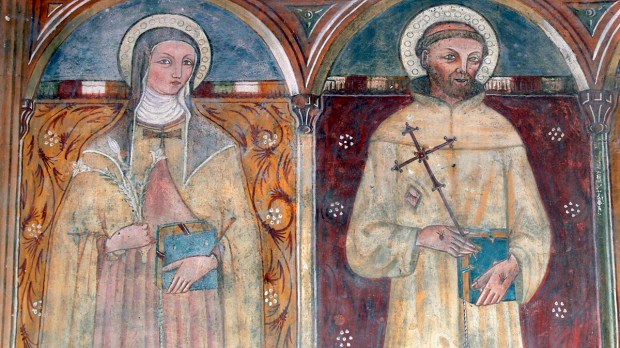Blessed are the peacemakers, for they will be called children of God.
(Matthew 5:9)
As the war in Eastern Europe unfolds, many people of faith are turning to prayer and searching for answers. During these times, it can be beneficial to look at the experience of the saints.
Though Sts. Francis and Clare of Assisi lived some eight centuries ago, their lives were also affected by the tragedies of war and violence.
In 1215, Pope Innocent III launched the Fourth Lateran Council, in which he called for a fifth crusade. St. Francis was likely present at the council, and he heard the call. After two failed attempts, in 1219 he arrived in the Holy Land. However, he was there as a different sort of crusader. He did not arrive with arms; he had a different plan.
The earliest account of this well-known encounter comes from the first biography of St. Francis by Thomas of Celano. Written in 1228,, just two years after the saint’s death, it was commissioned by the pope as the first official life story of St. Francis.
According to Thomas, Francis “would not rest from carrying out fervently the holy impulse of his spirit” – that is, martyrdom. Therefore, in the “thirteenth year of his conversion” (1219), he journeyed to Syria by ship and walked courageously with an unnamed companion across the battle lines to confront the “Sultan of the Saracens.”
While details of the exchange are not recorded, Thomas indicates that the sultan was struck by Francis’ witness, demeanor, and disdain for wealth, and he recognized that there was something unique about him. The account concludes with a statement that Francis did not receive his sought-after martyrdom, though he suggests that God was saving the moment for his later reception of the stigmata.
St. Bonaventure, a Franciscan theologian and later Minister General of the order, also wrote a biography of St. Francis in 1263. Bonaventure’s account mirrors Thomas’ almost verbatim, but differs primarily in the addition of Francis challenging the sultan’s priests to a trial by fire, “so that [the sultan] will recognize which faith deserves to be held as the holier and more certain.”
While Francis’s desire for martyrdom may strike some today as antiquated, it is consistent with the historic person of St. Francis. St. Francis was so devoted to Christ crucified that he sought to imitate him in every way – even going to the “cross” of martyrdom.
When Francis converted to the life of a penitent and signed his tunic with a cross, he became a “cross bearer” like the crusaders who also wore a cross over their armor. Though he had laid down his own arms, he was still a warrior at heart, fighting a spiritual crusade. His arms were now the Word and the cross, his armor the penitential tunic.
It is not likely that Francis supported the crusades, as he never mentioned them in any of his writings. Moreover, his own experience in battle before his conversion and his renunciation of arms is telling. His life trajectory makes it clear that he had rejected every form of violence. He had become fully nonviolent.
Though the sultan did not convert and Francis was not martyred, the encounter led to a significant breakthrough. According to Thomas, Francis was received “very graciously” by the sultan, who “honored him as much as he could, offering him many gifts.” Two of those gifts – an ivory horn and an Islamic prayer mat – are preserved within the Basilica of St. Francis in Assisi to this day.
More importantly, after the encounter, the witness of Francis led the sultan to turn over the administration of the Christian sites in his territory to Francis and his order. This was an extraordinary gesture in that safe passage for Christians in the Holy Land was one of the primary motives the crusades were launched in the first place. The Franciscans continue to care for the Holy Land today.
Clare, from a family of knights
St. Clare of Assisi also came of age in a milieu marked by violence. After an uprising in 1199, Clare, at just 8 years old, was exiled to Perugia with the other noble families of Assisi. Her father, uncles, and cousins were all knights. It is likely that they had experience in battle. When they went out, they would have been armed with swords and scabbards on their hips. Weaponry including lances, shields, and battle axes would have been fixtures within the castle where Clare grew up.
When she was 18 years old, Clare had an experience with Jesus Christ. She, too, posed the same question to the Lord as the rich young man who inquired how to inherit eternal life. But she listened and did what he said, “Go, sell what you have, give the money to the poor, and come and follow me” (see Matthew 19:16–30; Mark 10:17–31; Luke 18:18–30).
Throughout her life, Clare reflected and meditated on the crucifixion and what her Lord had sacrificed for her. She yearned to imitate the crucified Christ and to offer herself, like him, as a sacrifice to save others. In the Process of Canonization, three sisters testified that Clare had a desire to be a martyr in the Holy Land.
Clare had her opportunity toward the end of her life, in Assisi, when an army of Saracen soldiers tried to attack San Damiano.
The year was 1240, the hour tierce (9:00 a.m.), when they appeared suddenly “swarming like bees.” Though the sisters were terrified, Clare told them not to fear and to have confidence in Christ because he would defend them.
Taking to heart the words of Jesus, “Greater love has no man than this, that a man lay down his life for his friends” (John 15:13), she said to her sisters, “I wish to be your ransom; if it should happen that the enemies come into [San Damiano], place me before them.”
Clare did not know what would happen to her as she asked the friars to bring to her the holy Eucharist reposed in a silver pyx inside an ivory box. Before the door to the refectory, Clare lay prostrate before the Lord in the Eucharist while awaiting what she believed would be her martyrdom.
When the Saracens broke through the gate and entered the enclosure, they stopped in their tracks. They were disarmed by this mysterious, veiled woman. She was not afraid of them. Clare possessed a strength infinitely more powerful than them with their weapons and physical force.
St. Clare was practicing perhaps the most challenging imperative of the Gospel: “Love your enemies, do good to those who hate you, bless those who curse you, pray for those who abuse you. To him who strikes you on the cheek, offer the other also; and from him who takes away your coat do not withhold even your shirt” (Luke 6:27-29.
The Saracens were so disoriented that they fled. There was no violence that day.
Violence can’t be countered with violence
In their approach to peacemaking and peace, Sts. Francis and Clare did not counter violence with more violence. Instead, they sought to imitate Christ.
When Christ was being arrested, he rebuked Peter who sought to defend him saying, “Put your sword back into its place; for all who take the sword will perish by the sword” (Matthew 26:52).
Later, during his interrogation with Pontius Pilate, he said, “My kingship is not of this world; if my kingship were of this world, my servants would fight, that I might not be handed over to the Jews; but my kingship is not from the world” (John 18:36).
Christ makes it clear that his Kingdom is heavenly, beyond the world. Though the Catholic Church allows for legitimate defense (see CCC 2263-2267) and “just war” under some circumstances (see CCC 2307-2317), the way Saints Francis and Clare sought to imitate Christ shows a radical way to confront war and violence.
~
In Bret Thoman’s book, A Knight and a Lady: A Journey into the Spirituality of Saints Francis and Clare, he writes about peace and peacemaking and other elements of Franciscan spirituality.


